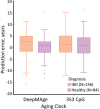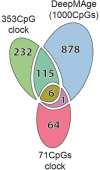DeepMAge: A Methylation Aging Clock Developed with Deep Learning
- PMID: 34341706
- PMCID: PMC8279523
- DOI: 10.14336/AD.2020.1202
DeepMAge: A Methylation Aging Clock Developed with Deep Learning
Abstract
DNA methylation aging clocks have become an invaluable tool in biogerontology research since their inception in 2013. Today, a variety of machine learning approaches have been tested for the purpose of predicting human age based on molecular-level features. Among these, deep learning, or neural networks, is an especially promising approach that has been used to construct accurate clocks using blood biochemistry, transcriptomics, and microbiomics data-feats unachieved by other algorithms. In this article, we explore how deep learning performs in a DNA methylation setting and compare it to the current industry standard-the 353 CpG clock published in 2013. The aging clock we are presenting (DeepMAge) is a neural network regressor trained on 4,930 blood DNA methylation profiles from 17 studies. Its absolute median error was 2.77 years in an independent verification set of 1,293 samples from 15 studies. DeepMAge shows biological relevance by assigning a higher predicted age to people with various health-related conditions, such as ovarian cancer, irritable bowel diseases, and multiple sclerosis.
Keywords: DNA methylation; aging; artificial intelligence; epigenetics.
copyright: © 2021 Galkin et al.
Conflict of interest statement
Conflicts of interest Deep Longevity and Insilico Medicine are for-profit organizations developing artificial intelligence solutions for aging research, drug discovery, and longevity medicine. A patent has been applied for the described model and accompanying method.
Figures




Similar articles
-
Adapting Blood DNA Methylation Aging Clocks for Use in Saliva Samples With Cell-type Deconvolution.Front Aging. 2021 Jul 29;2:697254. doi: 10.3389/fragi.2021.697254. eCollection 2021. Front Aging. 2021. PMID: 35822029 Free PMC article.
-
ResnetAge: A Resnet-Based DNA Methylation Age Prediction Method.Bioengineering (Basel). 2023 Dec 28;11(1):34. doi: 10.3390/bioengineering11010034. Bioengineering (Basel). 2023. PMID: 38247911 Free PMC article.
-
Pan-tissue methylation aging clock: Recalibrated and a method to analyze and interpret the selected features.Mech Ageing Dev. 2022 Jun;204:111676. doi: 10.1016/j.mad.2022.111676. Epub 2022 Apr 27. Mech Ageing Dev. 2022. PMID: 35489615
-
Biohorology and biomarkers of aging: Current state-of-the-art, challenges and opportunities.Ageing Res Rev. 2020 Jul;60:101050. doi: 10.1016/j.arr.2020.101050. Epub 2020 Apr 6. Ageing Res Rev. 2020. PMID: 32272169 Review.
-
Epigenetic clocks provide clues to the mystery of uterine ageing.Hum Reprod Update. 2023 May 2;29(3):259-271. doi: 10.1093/humupd/dmac042. Hum Reprod Update. 2023. PMID: 36515535 Review.
Cited by
-
Adapting Blood DNA Methylation Aging Clocks for Use in Saliva Samples With Cell-type Deconvolution.Front Aging. 2021 Jul 29;2:697254. doi: 10.3389/fragi.2021.697254. eCollection 2021. Front Aging. 2021. PMID: 35822029 Free PMC article.
-
Loxl2 is a mediator of cardiac aging in Drosophila melanogaster, genetically examining the role of aging clock genes.G3 (Bethesda). 2022 Jan 4;12(1):jkab381. doi: 10.1093/g3journal/jkab381. G3 (Bethesda). 2022. PMID: 34734976 Free PMC article.
-
pyaging: a Python-based compendium of GPU-optimized aging clocks.Bioinformatics. 2024 Mar 29;40(4):btae200. doi: 10.1093/bioinformatics/btae200. Bioinformatics. 2024. PMID: 38603598 Free PMC article.
-
Methods for Estimating Personal Disease Risk and Phylogenetic Diversity of Hematopoietic Stem Cells.Mol Biol Evol. 2024 Jan 3;41(1):msad279. doi: 10.1093/molbev/msad279. Mol Biol Evol. 2024. PMID: 38124397 Free PMC article.
-
Precious1GPT: multimodal transformer-based transfer learning for aging clock development and feature importance analysis for aging and age-related disease target discovery.Aging (Albany NY). 2023 Jun 13;15(11):4649-4666. doi: 10.18632/aging.204788. Epub 2023 Jun 13. Aging (Albany NY). 2023. PMID: 37315204 Free PMC article.
References
-
- Schwartz PJ, O’Neill DV, Bentz ME, Brown A, Doyle BS, Liepa OC, et al.. (2020). AI-enabled wargaming in the military decision making process. Proc SPIE, 11413:14130H.
-
- Zhavoronkov A, Ivanenkov YA, Aliper A, Veselov MS, Aladinskiy VA, Aladinskaya AV, et al.. (2019). Deep learning enables rapid identification of potent DDR1 kinase inhibitors. Nat Biotechnol, 37:1038-1040. - PubMed
LinkOut - more resources
Full Text Sources
